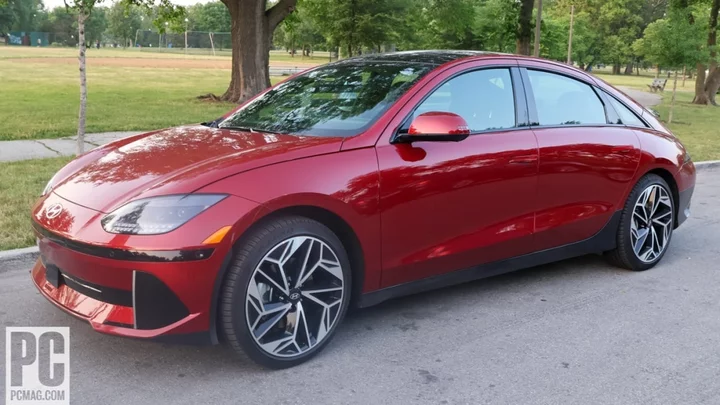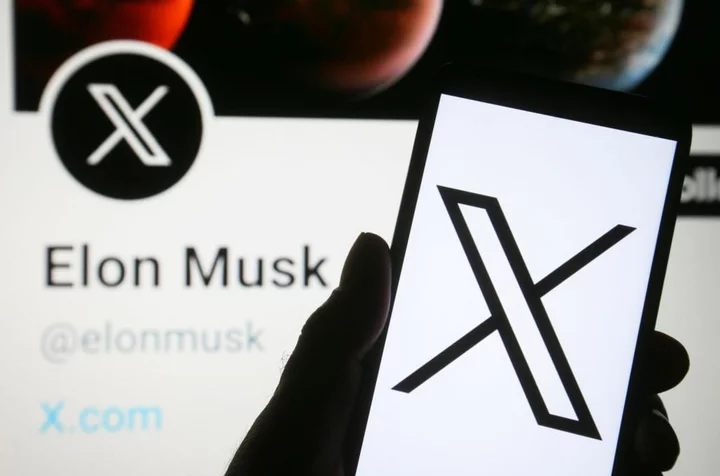Starting at $41,600, the Hyundai Ioniq 6 is the rare affordable EV sedan merging into a market overpopulated with crossovers, SUVs, and trucks. Hyundai is forging ahead with a four-door for those who still want a traditional car powered by a battery instead of petroleum. The Ioniq 6 has a wide range of battery and motor variants for your budget, includes twin dashboard displays, and packs other perks to pique your interest. Moreover, the Ioniq 6 is a more modern machine with a far keener sense of style than competing sedans. However, while the Tesla Model 3 ($38,990) is somewhat staid next to the Ioniq 6, it earns the $7,500 federal tax credit and remains our Editors' Choice winner in this price range for its class-leading range and fun driving experience.
Trims Levels, Battery Range, and Charge Times
The 2023 Hyundai Ioniq 6 comes in three trim levels, segmented by front-wheel-drive, all-wheel-drive, range, and starting price. These include:
The SE Standard Range RWD trim has a 111kW/149 horsepower (hp) motor powered by a 53kWh battery, while the other RWD trims come with a 168kW/225hp motor powered by a 77.4kWh battery. The AWD trims have a 74kW front motor and a 165kW rear motor for a total of 320hp powered by a 77.4kWh battery. The RWD models all produce 258lb.-ft. of torque, while the dual-motor AWD trims jump to 446lb.-ft of torque. All models have a single-speed reduction-gear transmission.
(Credit: Emily Dreibelbis)The charge times for the SE Standard Range RWD are 18 minutes with a Level 1 fast charger operating at 350kW, 58 minutes with a Level 1 fast charger operating at 50kW up to an 80% charge, and 5 hours and 20 minutes with a Level 2/120V charger up to an 80% charge. For the other trims, charge times are 18 minutes with a Level 1 fast charger operating at 350kW, 73 minutes with a Level 1 fast charger operating at 50kW up to an 80% charge, and 6 hours and 55 minutes with a Level 2/120V charger up to an 80% charge.
Of note, the car will be able to use Tesla's chargers starting in 2025, which should net quicker charge times at those locations.
We tested the SE RWD model with $210 carpeted floor mats as the only option. With a $1,115 inland freight and handling fee, the final sticker came to $46,825. The SE and the SEL trims are equipped with standard exterior features such as 18-inch alloy wheels, front and rear LED lighting with fog lamps, heated and body-color power side mirrors, and a powered charge-port door.
(Credit: Emily Dreibelbis)The inside features a 12.3-inch digital instrument cluster, a 12.3-inch HD infotainment touch screen with navigation, Android Auto and Apple CarPlay, Bluetooth, cloth seats with an eight-way power driver seat and a six-way manual adjustable passenger seat, dual-zone automatic climate control, heated front seats, a leather-wrapped steering wheel, a USB-A data/charging port, and four USB-C charging ports (two front and two rear).
Standard driver assists include adaptive cruise control, automatic emergency braking, blind-spot warning, driver-attention warning, forward-collision assist with pedestrian and cyclist detection, front and rear parking sensors, lane centering, lane-keeping assist, rear cross-traffic assist, and safe-exit warning.
(Credit: Doug Newcomb)The SEL trim adds 20-inch wheels, adaptive cruise control with machine learning that adapts to a driver’s behavior, an auto-dimming rearview mirror, blind-spot assist, dual-color and speed-sensing ambient lighting, forward-collision-avoidance with junction turning that detects an oncoming vehicle from an adjacent lane turning left, synthetic-leather-trimmed seating surfaces, upgraded lane centering, and wireless device charging.
Last, the Limited adds an 8-way power passenger seat, a blind-spot view monitor in the instrument cluster, Bose premium audio, a heated steering wheel, Hyundai’s Vehicle-to-Load feature to power portable electronics, memory settings for the driver’s seat, a panoramic sunroof, power-folding side mirrors, premium gloss-black exterior accents, rain-sensing wipers, remote parking, surround-view monitor, and ventilated front seats.
Distinctive Exterior Design
Like its corporate sibling, the Ioniq 6 has a distinctive and bold exterior design with a long hood, a truncated rear end, and prominent shoulders that run the length of the car from the headlights to the taillights. The front lighting, which Hyundai calls a Parametric Pixel design, is borrowed from the Ioniq 5, and a vehicle-width taillight narrows to points and wraps around the corners of the car. The twin double-decker spoiler is another distinguishing but functional design element, and the Ioniq 6 has flush door handles and a translucent shark-fin antenna.
(Credit: Emily Dreibelbis)The interior likewise has a modern and minimalist look similar to the Ioniq 5 with shared elements including dual-dashboard screens and tasteful use of silver-plastic accents. The wings on each side of the dash are unique to the Ioniq 6, as are the round Drive Mode button on and LEDs embedded in the steering wheel to indicate charge status. A flat floor adds a sense of spaciousness to the rear, and while the front seat area is roomy and the back is adequate for average adults, the trunk has only 11.2 cubic feet of storage with the rear seats in place (they fold down to expand cargo capacity). The 0.5-cubic-foot frunk is mostly useless.
Double Dashboard Displays
The Ioniq 6 features side-by-side 12.3-inch infotainment and instrument panel screens that are identical to those in the Ioniq 5. The infotainment screen has a look and layout like other Hyundai vehicles we’ve tested, but uses light-blue icons on a white background (instead of a black background) that are easier on the eyes and give the interface a brighter, cleaner look. The icons are organized on multiple pages and can be rearranged like on a smartphone screen. The instrument panel follows a similar color scheme so that it's easier to understand what you're seeing. The heads-up display has an innovative augmented-reality mode that projects info such as speed limit, driver-assist warnings, and images of other vehicles around the car.
(Credit: Emily Dreibelbis)The infotainment screen provides critical EV info such as battery range, charging times when plugged in, and state of charge, and it can help to schedule charging. The onboard navigation system can locate charging stations within a definable radius. Android Auto and Apple CarPlay supply connectivity for things like phone calls, messaging, music, and more. Other connected features such as telematics services (automatic crash notification, emergency roadside assistance, and vehicle settings) are available via Hyundai’s subscription-based Bluelink system that’s free for the first three years of ownership ($99 per year or $9.90 per month thereafter). Bluelink also lets you store personal vehicle settings in the cloud, such as seat and mirror positions and screen cluster layouts for each driver. Via the Bluelink app, you can access remote features such as door lock/unlock and climate control, find charging stations by charge type and availability, and send a location to the car’s nav system.
(Credit: Doug Newcomb)If you like buttons more than touch screens, the Ioniq 6 has you covered. An array of buttons and other physical controls sits below the secondary infotainment screen, providing quick access to select functions. The Tesla Model 3, by comparison, is all screen.
Impressive, If Not Quite Sporty, Performance
(Credit: Doug Newcomb)In Sport mode, the 225hp motor of our RWD test vehicle provided a linear and fun rush of near-silent power (assuming you've turned off the artificial engine noise). The more powerful and expensive 320hp dual-motor AWD versions are undoubtedly much quicker—although not Tesla Ludicrous fast.
The Ioniq 6's ride is smooth and handling is nimble, with its low center of gravity (and hefty 4,000-pound curb weight) keeping it planted while still cornering quickly. Steering wheel paddles let you select from three different levels of regenerative braking, with the highest providing a one-pedal driving feel.
A Taxing Difference
If you want to buck the American buying trend of crossovers, SUVs, and trucks, the list of EV sedans is a short one—and they’re mostly luxury cars such as the Lucid Air ($138,000) and the Tesla Model S ($74,990). For an affordable model, we like the exterior styling of the Ioniq 6 better than the Model 3’s basic design, and the Ioniq 6 has a more luxurious and modern interior. It also has better tech amenities such as Android Auto and Apple CarPlay, Hyundai’s Vehicle-to-Load feature, and the latest driver assists. But the base Model 3 RWD ($38,990) has 272 miles of range and runs farther than the base Ioniq 6 SE Standard Range RWD ($41,600) can at 240 miles. Moreover, while we prefer the Ioniq 6, the Model 3 qualifies for the $7,500 federal tax credit, further reducing its price—and the Hyundai doesn't. Thus, the Model 3 retains its Editors’ Choice crown in the midsize EV sedan category.









